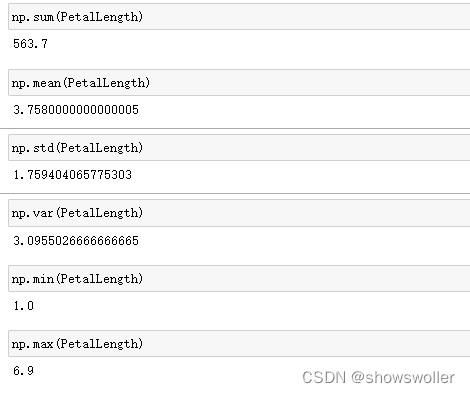需要源码和数据集请点赞关注收藏后评论区留言私信~~~
下面读取iris数据中鸢尾花的萼片、花瓣长度数据,并对其进行排序、去重、并求出和、累计和、均值、标准差、方差、最小值、最大值等操作
1:导入模块
2:获取数据并打印如下

iris_data = []
with open("data//iris.csv") as csvfile:
# 使用csv.reader读取csvfile中的文件
csv_reader = csv.reader(csvfile)
# 读取第一行每一列的标题
birth_header = next(csv_reader)
# 将csv 文件中的数据保存到birth_data中
for row in csv_reader:
iris_data.append(row)
iris_data3:数据清理 去掉索引号

iris_list = []
for row in iris_data:
iris_list.append(tuple(row[1:]))
iris_list4:数据统计
首先创建数据类型
![]()
datatype = np.dtype([("Sepal.Length", np.str_, 40), ("Sepal.Width", np.str_, 40),
("Petal.Length",np.str_, 40), ("Petal.Width", np.str_, 40),("Species",np.str_, 40)])
print(datatype)然后创建二维数组

iris_data = np.array(iris_list,dtype = datatype)
iris_data然后将待处理的数据类型转化为float类型

PetalLength =iris_data["Petal.Length"].astype(float)
PetalLength接着将数据排序

np.sort(PetalLength)接着进行数据去重

np.unique(PetalLength)最后对指定列求和 均值 标准差 方差 最小值以及最大值
sum: 计算数组的和
mean 计算数组均值
std 计算数组标准差
var 计算数组方差
min 计算数组最小值
max 计算数组最大值
argmin 返回数组最小元素的索引
argmax 返回数组最小元素的索引
cumsum 计算所有元素的累计和
cumprod 计算所有元素的累计积

创作不易 觉得有帮助请点赞关注收藏~~~
























 1318
1318











 被折叠的 条评论
为什么被折叠?
被折叠的 条评论
为什么被折叠?










